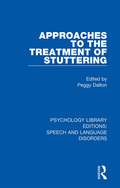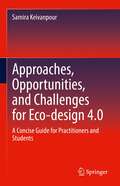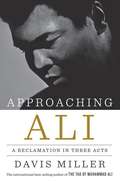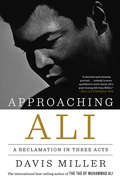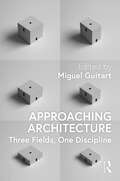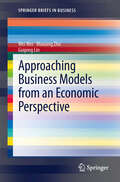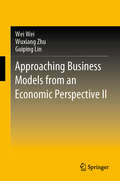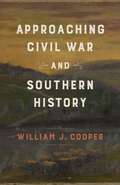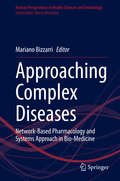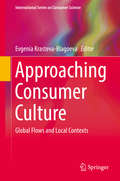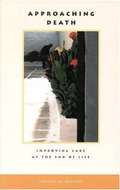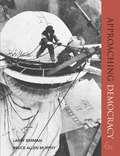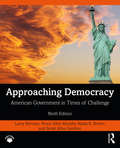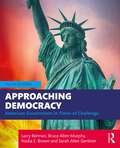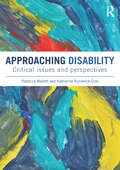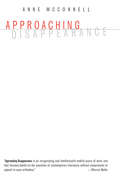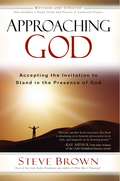- Table View
- List View
Approaches to the Treatment of Stuttering (Psychology Library Editions: Speech and Language Disorders)
by Peggy DaltonIn the years prior to publication ‘cures’ for stuttering seemed to appear constantly, but many were of limited value, were poorly evaluated and gave only a temporary alleviation that was not transferred to daily life. More responsible clinicians produced publications expounding one particular approach to therapy but less was available giving a balanced overview which was of practical help to therapists. Originally published in 1983, this book aimed to provide such an overview, with a focus on practical intervention rather than on theory. The need for careful assessment is particularly stressed and also the need for flexibility in the choice of treatment for any one client. Changes in fluency are looked at in relation to the effects they might have on the person’s life as a whole and factors involved in the maintenance of this change are discussed. In addition, adjuncts to speech therapy, such as drugs, hypnosis and various forms of masking are evaluated. Issues of the training of therapists are raised and suggestions made as to the nature of the therapeutic relationship when working with people who stutter.
Approaches, Opportunities, and Challenges for Eco-design 4.0: A Concise Guide for Practitioners and Students
by Samira KeivanpourThis book addresses the implications of the Industry 4.0 paradigm in design for the environment. We examine the opportunities for, and challenges of, the implications of cyber-physical systems, big data analytics, Internet of things, additive manufacturing, and simulation in a range of areas in an eco-design context. These include selecting low impact materials, choosing manufacturing processes with environmental considerations, end of life strategies, applying design approaches for disassembly, integrating economic and social components into environmental studies, and stakeholder’s involvement. This volume takes a step toward this journey to explore how the three pillars of technology, sustainability, and evolving consumers could shape the future of the product’s design.
Approaching Ali: A Reclamation in Three Acts
by Davis MillerOn Easter weekend 1988, then struggling writer and movie store clerk Davis Miller drove to Muhammad Ali's mother's modest house in Louisville, knocked on the front door, and waited for an answer. It had been over two decades since he'd first glimpsed The Champ on a black-and-white television--when Miller was an eleven-year-old boy, shattered by the unexpected loss of his mother--and he felt the time had come for him to personally thank the man whose fearlessness, grace, and tenacity gave him the power to overcome a near-paralyzing depression. When the door finally opened, Miller would not only get to meet his "spiritual constant" but also begin a surprising and tender new friendship that would forever transform his life. Today, more than twenty-five years later, the two still share an uncommon bond, the sort that can be fashioned only in serendipitous ways and fortified through shared experiences. Miller now draws from those remarkable moments to give us a quietly startling portrait of a great man physically ravaged but spiritually young. Beginning with a series of three interconnected anecdotes about Miller's first meeting with the champ--which formed the basis of "My Dinner with Ali," a legendary piece of sports journalism that was anthologized in The Best American Sports Writing of the Century--Approaching Ali continues as a historic tribute, composed of linked vignettes spread out over decades, that is unlike anything else that has been written about one of the world's most famous and loved men. As readers will discover in these pages, Miller is the Everyman, Ali the Superman in physical decline. Commingled together, the two voices form the all-time most intimate portrait of Ali's day-by-day life in his postboxing career. Through Miller's eyes, we witness the aging and ailing Ali playing mischievous tricks on unsuspecting guests, performing sleight of hand for any willing audience, and walking over ten miles each day to enjoy an ice cream sundae and talk with strangers. Miller goes on to reveal a side of the boxing legend we never knew was there, whether it be Ali handing out hundred-dollar bills at a Los Angeles bus stop, showing a group of inner-city children the ocean for the very first time, or unexpectedly cracking jokes with the distinctly insightful words he is still able to summon. Following in the grand contemporary literary tradition of writers such as Gay Talese, Tom Wolfe, and Nick Hornby, Miller gives us a series of extraordinary insights into a man that he has been approaching nearly his entire life. The result is both a new introduction to the human side of a boxing legend as well as a loving and beautifully written reclamation of Muhammad Ali's life after the ring.
Approaching Ali: A Reclamation in Three Acts
by Davis MillerThe single most intimate look at Muhammad Ali’s retirement, told through the story of an unexpected, powerful and life-changing friendship In 1988, then struggling writer and video store worker Davis Miller drove to Muhammad Ali’s mother’s modest Louisville house, knocked on the door, and introduced himself to his childhood idol. Now, all these years later, the two friends have an uncommon bond, the sort that can be fashioned only in serendipitous ways and fortified through shared experiences. Miller draws from his remarkable moments with The Champ to give us a beautifully written portrait of a great man physically devastated but spiritually young—playing mischievous tricks on unsuspecting guests, performing sleight of hand for any willing audience, and walking ten miles each way to grab an ice cream sundae. Informed by great literary journalists such as Joan Didion, Tom Wolfe, and Gay Talese, but in a timeless style that is distinctly his own, Miller gives us a series of extraordinary stories that coalesce into an unprecedentedly humanizing, intimate, and tenderly observed portrait of one of the world’s most loved men.
Approaching Architecture: Three Fields, One Discipline
by Miguel GuitartThe study of the architectural discipline suffers from an increasing disconnect between its teaching and its professional practice. In this edited collection, 18 architectural voices address this disconnect by reflecting on the ways in which they exercise the architectural discipline in three ways: research, teaching, and practice. This book argues that the totality of activities encompassed by the architectural profession can be best fulfilled when reconsidering the critical interactions between these three fields in the everyday exercise of the profession. Split into three parts, "Architecture as Research," Architecture as Pedagogy," and "Architecture as Practice," each section focuses on one of these three dimensions while establishing continuity with the other two. In doing so, the book not only favors a more fulfilling interaction between academia and the profession but also reinforces the implementation of design theory and research in everyday teaching and practice. The contributions come from 18 teams of architects operating from geographically diverse locations, including Pezo von Ellrichshausen in Chile, Kengo Kuma & Associates in Japan, Barclay & Crousse in Peru, Shift in Iran, Heinrich Wolff in South Africa, and People’s Architecture Office in China, opening the design conversation to larger contexts and framing continuity and inclusion in time. Written for students, instructors, and practitioners alike, the inspiring reflections in this volume encourage readers to grow as architects and play an instrumental role in transforming the built environment.
Approaching Architecture: Three Fields, One Discipline
by Miguel GuitartThe study of the architectural discipline suffers from an increasing disconnect between its teaching and its professional practice. In this edited collection, 18 architectural voices address this disconnect by reflecting on the ways in which they exercise the architectural discipline in three ways: research, teaching, and practice. This book argues that the totality of activities encompassed by the architectural profession can be best fulfilled when reconsidering the critical interactions between these three fields in the everyday exercise of the profession. Split into three parts, "Architecture as Research," Architecture as Pedagogy," and "Architecture as Practice," each section focuses on one of these three dimensions while establishing continuity with the other two. In doing so, the book not only favors a more fulfilling interaction between academia and the profession but also reinforces the implementation of design theory and research in everyday teaching and practice. The contributions come from 18 teams of architects operating from geographically diverse locations, including Pezo von Ellrichshausen in Chile, Kengo Kuma & Associates in Japan, Barclay & Crousse in Peru, Shift in Iran, Heinrich Wolff in South Africa, and People’s Architecture Office in China, opening the design conversation to larger contexts and framing continuity and inclusion in time. Written for students, instructors, and practitioners alike, the inspiring reflections in this volume encourage readers to grow as architects and play an instrumental role in transforming the built environment.
Approaching Business Models from an Economic Perspective (SpringerBriefs in Business)
by Wuxiang Zhu Wei Wei Guiping LinApproaching Business Models from an Economic Perspective examines business model logic and explores the model from different aspects including definition, design, functionality, elements, and self-sustaining logic. It explains the essence and core elements of a business model and unlocks its mysteries, helping transform business model practices into an expedient set of theories that in turn facilitate application in real scenarios. The book explores the logic behind the six major elements and enables entrepreneurs to study and implement business model theory and make decisions confidently based on a compelling logic. Moreover, it demonstrates through an array of convincing examples that a transaction structure and its six elements follow the principles of increasing transaction value, reducing transaction costs, and mitigating transaction risks.
Approaching Business Models from an Economic Perspective II
by Wuxiang Zhu Wei Wei Guiping LinThis book breaks the boundaries of the single enterprise, proposing the symbiotic business model, and discussing business model design engineering as well as other new concepts, methods and ideas. Business models are not only dependent on business intuition, but also on systematic design and continuous upgrade. This book presents qualitative methods, such as the theory and principles of business model design; quantitative methods, for example the business-model based "Accounting Method"; and the "Financial Analysis Method," based on the business ecosystem. These methods help entrepreneurs and managers design better business models to further develop enterprises and make them more successful.
Approaching China's Pharmaceutical Market: A Fundamental Guide to Clinical Drug Development
by Ming Q. LuThis authoritative volume examines the major laws, regulations and guidelines related to pharmaceutical product development in China. With a focus on patent, clinical and registration strategies, the book helps Western companies introduce their clinical drugs to the Chinese market, determine a strategic path and bridge the gap for regulatory and legal differences between China and the Western world. For a better understanding of the drug registration process, it explores the differences between the China Food and Drug Administration (CFDA)--including its regulations and registration procedures--and those of the Western world. The volume discusses disparities between China's application requirements compared to Western standards to make it easier for companies to prepare their application packages. It also provides detailed commentary on CFDA guidelines in reference to clinical trial (IND) and market application (NDA) requirements. Overall, this book offers guidance for Western companies aspiring to expand into China's pharmaceutical market in hopes that they may gain a fundamental understanding of its rules and complexities in order to ensure a smooth transition and prevent future issues.
Approaching Civil War and Southern History
by William J. Cooper Jr.Initially published between 1970 and 2012, the essays in Approaching Civil War and Southern History span almost the entirety of William J. Cooper’s illustrious scholarly career and range widely across a broad spectrum of subjects in Civil War and southern history. Together, they illustrate the broad scope of Cooper’s work. While many essays deal with his well-known interests, such as Jefferson Davis or the secession crisis, others are on lesser-known subjects, such as Civil War artist Edwin Forbes and the writer Daniel R. Hundley. In the new introduction to each chapter, Cooper notes the essay’s origins and purpose, explaining how it fits into his overarching interest in the nineteenth-century political history of the South. Combined and reprinted here for the first time, the ten essays in Approaching Civil War and Southern History reveal why Cooper is recognized today as one of the most influential historians of our time.
Approaching College with Purpose
by Amy Lee Catherine Lee Margaret Delehanty Kelly Maggie BergeronApproaching College with Purpose focuses on the importance of students beginning their educational journey with intention, developing good habits, creating a strong mindset, and acquiring strategies to ensure a successful transition to college. Delivered with a concise, approachable, and modern tone that respects students, the text and student journal emphasize the importance of communication, critical thinking, and collaboration. Ideal for First-Year Experience and College Success programs, the text and student journal are designed to acknowledge and respect students’ unique perspectives, focus on students owning their experience, put the emphasis on communication, especially writing, and provide just-in-time skill-building resources. The content provides an integrated approach to life skills, academic success, and well-being, with a focus on building lifelong skills. <p><p> Written by educators, with a unique perspective from a student-author, the textbook and student journal are based on decades of teaching and research, designed to create a transformative experience for students. It promotes self-reflection, mindset, and diversity, with the ultimate goal of setting students on a path toward owning their experiences, and approaching college, and life, with purpose.
Approaching Complex Diseases: Network-Based Pharmacology and Systems Approach in Bio-Medicine (Human Perspectives in Health Sciences and Technology #2)
by Mariano BizzarriThis volume – for pharmacologists, systems biologists, philosophers and historians of medicine – points to investigate new avenues in pharmacology research, by providing a full assessment of the premises underlying a radical shift in the pharmacology paradigm. The pharmaceutical industry is currently facing unparalleled challenges in developing innovative drugs. While drug-developing scientists in the 1990s mostly welcomed the transformation into a target-based approach, two decades of experience shows that this model is failing to boost both drug discovery and efficiency. Selected targets were often not druggable and with poor disease linkage, leading to either high toxicity or poor efficacy. Therefore, a profound rethinking of the current paradigm is needed. Advances in systems biology are revealing a phenotypic robustness and a network structure that strongly suggest that exquisitely selective compounds, compared with multitarget drugs, may exhibit lower than desired clinical efficacy. This appreciation of the role of polypharmacology has significant implications for tackling the two major sources of attrition in drug development, efficacy and toxicity. Integrating network biology and polypharmacology holds the promise of expanding the current opportunity space for druggable targets.
Approaching Consumer Culture
by Evgenia Krasteva-BlagoevaThis fascinating collection analyzes the impact of Western consumer culture on local cultures and consumption in Southeast Europe and East Asia. Cultural, historical, economic and sociopolitical contexts are examined regarding buying behaviors, usage and customization practices and consumer activism, specifically in Bulgaria, Serbia, and Romania as cultures continue to evolve in the post-socialist era, and in China and Japan as a continuation of movements toward modernity and progress. Surprising and thought-provoking contrasts stand out as consumers balance the global with the local in terms of clothing, technology, luxury items, and food. All chapters feature a wealth of empirical and cross-cultural data, and the presentation is framed by Professor Mike Featherstone’s theoretical essay on the origins of consumer culture and the consequences of two hundred years of increasing consumption for the human condition and the future of the planet.Included in the coverage:“You are a socialist child like me”: Goods and Identity in BulgariaConsumer Culture from Socialist Yugoslavia to Post-Socialist Serbia: Movements and MomentsPreserves Exiting Socialism: Authenticity, Anti-Standardization, and Middle-Class Consumption in Post-Socialist RomaniaModernization and the Department Store in Early 20th-Century Japan: Modern Girl and New Consumer Culture LifestylesA Cultural Reading of Conspicuous Consumption in ChinaApproaching Consumer Culture broadens the cultural anthropology literature and will be welcomed by Western and Eastern scholars and researchers alike. Its depth and accessibility make it useful to university courses in cultural anthropology, cultural studies, and sociology.
Approaching Death: IMPROVING CARE AT THE END OF LIFE
by Committee on Care at the End of LifeWhen the end of life makes its inevitable appearance, people should be able to expect reliable, humane, and effective caregiving. Yet too many dying people suffer unnecessarily. While an "overtreated" dying is feared, untreated pain or emotional abandonment are equally frightening.Approaching Death reflects a wide-ranging effort to understand what we know about care at the end of life, what we have yet to learn, and what we know but do not adequately apply. It seeks to build understanding of what constitutes good care for the dying and offers recommendations to decisionmakers that address specific barriers to achieving good care.This volume offers a profile of when, where, and how Americans die. It examines the dimensions of caring at the end of life: Determining diagnosis and prognosis and communicating these to patient and family. Establishing clinical and personal goals. Matching physical, psychological, spiritual, and practical care strategies to the patient's values and circumstances. Approaching Death considers the dying experience in hospitals, nursing homes, and other settings and the role of interdisciplinary teams and managed care. It offers perspectives on quality measurement and improvement, the role of practice guidelines, cost concerns, and legal issues such as assisted suicide. The book proposes how health professionals can become better prepared to care well for those who are dying and to understand that these are not patients for whom "nothing can be done."
Approaching Democracy
by Bruce Allen Murphy Larry A. BermanUpdated in its 8th edition, Approaching Democracy addresses the evolving nature of the American experiment in democratic government. It teaches readers the theory and basics of American political science and the nation's political history. It provides the critical thinking skills needed to analyze these evolving relationships. Larry Berman and Bruce Allen Murphy are long-time teachers of the Introductory American Political Science course in both large and small public and private universities. Their goal was to write a book that offers a clear and relevant theme in an easily readable format.
Approaching Democracy (6th edition)
by Larry Berman Bruce Allen MurphyApproaching Democracy addresses the evolving nature of the American experiment in democratic government. It teaches students the theory and the basics of American political science, the political history of this nation, and provides the critical thinking skills needed to analyze these evolving relationships.
Approaching Democracy: American Government in Times of Challenge
by Larry Berman Bruce Allen Murphy Sarah Allen Gershon Nadia E BrownFrom unsubstantiated 2020 election fraud claims and the storming of the US Capitol to the rampage of COVID-19 and racial injustice, this book covers the foundations, institutions, and processes of "the great American experiment" with a clear and resonant theme: Democracy cannot be taken for granted, whether at home or internationally, and eternal vigilance (along with civic intelligence) is required to protect it. Approaching Democracy provides students with a framework to analyze the structure, process, and action of US government, institutions, and social movements. It also invites comparison with other countries. This globalizing perspective gives students an understanding of issues of governance and challenges to democracy here and elsewhere. At a moment of growing domestic terrorism, political hyper-partisanship, populism, identity politics, and governmental dysfunction, there is no better time to bring Approaching Democracy--a textbook based on Vaclav Havel’s powerful metaphor of democracy as an ideal and the American experiment as the closest approach to it--to a new generation of political science undergraduate students. NEW TO THE NINTH EDITION Two new authors, Nadia E. Brown and Sarah Allen Gershon, who bring refreshing intellectual and diverse perspectives to the text. Includes the tumultuous political context surrounding the Trump presidency, the 2020 elections, the 116th Congress, the Supreme Court, the COVID-19 crisis, and the fight for social and racial justice. Figures and tables reflect the latest available data and surveys. Two new features--Diversity and Democracy, highlighting the experiences of America’s diverse social groups and the role of identity politics—and Discussion Questions at the end of each chapter, assessing critical thinking skills. Critical contemporary events are explored throughout the book, including the attempted coup following the 2020 elections, the Trump administration’s handling of the COVID-19 pandemic, Black Lives Matter, protests in American cities that come to the epicenter of America’s approach to democracy, the changes in the Supreme Court and the federal court system, the growth of LGBTQ+ legal rights, and the alteration in American Federalism. New and updated data on public attitudes toward police brutality, DACA, voter suppression, healthcare, and the global climate movement are also covered.
Approaching Democracy: American Government in Times of Challenge
by Larry Berman Bruce Allen Murphy Sarah Allen Gershon Nadia E BrownDemocracy cannot be taken for granted, whether at home or internationally, and eternal vigilance (along with civic intelligence) is required to protect it. Approaching Democracy provides students with a framework to analyze the structure, process, and action of US government, institutions, and social movements. It also invites comparison with other countries. This globalizing perspective gives students an understanding of issues of governance and challenges to democracy here and elsewhere. At a moment of political hyper-partisanship, economic tensions, media misinformation, hyper-partisanship, and anxieties about the future of civil rights, this is the ideal time to introduce Approaching Democracy--a textbook based on Vaclav Havel’s powerful metaphor of democracy as an ideal and the American experiment as the closest approach to it--to a new generation of political science undergraduate students. NEW TO THE TENTH EDITION Updated to reflect the results of the 2022 midterm elections and explore the implications of Congressional redistricting, voting suppression, and voting rights legislation. Covers the first two years of the Biden administration and provides a thorough retrospective on the Trump presidency—including updates on the January 6 Commission findings and the Justice department’s investigation into Trump’s alleged misappropriation of classified government documents. Presents the developments on the Supreme Court including the appointment of its two newest justices and major recent decisions including controversial rulings on reproductive health, the separation of church and state, and the environment Explores the revival of NATO and other international alliances in the context of the Russian invasion of Ukraine New and updated material has also been provided regarding gun control, healthcare, labor rights, immigration, economic policy, COVID-19’s lingering impacts, and the ongoing struggle for social and racial justice in America.
Approaching Disability: Critical issues and perspectives
by Rebecca Mallett Katherine Runswick-ColeDisability Studies is an area of study which examines social, political, cultural, and economic factors that define 'disability' and establish personal and collective responses to difference. This insightful new text will introduce readers to the discipline of Disability Studies and enable them to engage in the lively debates within the field. By offering an accessible yet rigorous approach to Disability Studies, the authors provide a critical analysis of key current issues and consider ways in which the subject can be studied through national and international perspectives, policies, culture and history. Key debates include: The relationship between activism and the academy Ways to study cultural and media representations of disability The importance of disability history and how societies can change National and international perspectives on children, childhood and education Political perspectives on disability and identity The place of the body in disability theory This text offers real-world examples of topics that are important to debates and offers a much needed truly international scope on the questions at hand. It is an essential read for any individual studying, practising or with an interest in Disability Studies.
Approaching Disappearance
by Anne McconnellMaurice Blanchot (1907-2003), one of the most influential figures of twentieth-century French literature, produced a wide variety of essays and fictions that reflect on the complexities of literary work. His description of writing continually returns to a number of themes, such as solitude, passivity, indifference, anonymity, and absence--forces confronting the writer, but also the reader, the text itself, and the relations between the three. For Blanchot, literature involves a movement toward disappearance, where one risks the loss of self; but such a sacrifice, says Blanchot, is inherent in the act of writing. Approaching Disappearance explores the question of disappearance in Blanchot's critical work and then turns to five narratives that offer a unique reflection on the threat of disappearance and the demands of literature--work by Franz Kafka, Jorge Luis Borges, Louis-René Des Forêts, and Nathalie Sarraute.
Approaching Disappearance
by Anne McconnellMaurice Blanchot (1907-2003), one of the most influential figures of twentieth-century French literature, produced a wide variety of essays and fictions that reflect on the complexities of literary work. His description of writing continually returns to a number of themes, such as solitude, passivity, indifference, anonymity, and absence--forces confronting the writer, but also the reader, the text itself, and the relations between the three. For Blanchot, literature involves a movement toward disappearance, where one risks the loss of self; but such a sacrifice, says Blanchot, is inherent in the act of writing. Approaching Disappearance explores the question of disappearance in Blanchot's critical work and then turns to five narratives that offer a unique reflection on the threat of disappearance and the demands of literature--work by Franz Kafka, Jorge Luis Borges, Louis-René Des Forêts, and Nathalie Sarraute.
Approaching Eye Level
by Vivian GornickFrom an acclaimed feminist writer, essays on “loneliness . . . [the] limitations on friendship and intimacy, [honoring] the process of becoming oneself” (Mary Hawthorne, The New York Times Book Review).Seminal essays on loneliness, living in New York, friendship, feminism, and writing from nonfiction master Vivian Gornick.Vivian Gornick’s Approaching Eye Level is a brave collection of personal essays that finds a quintessentially contemporary woman (urban, single, feminist) trying to observe herself and the world without sentiment, cynicism, or nostalgia. Whether walking along the streets of New York or teaching writing at a university, Gornick is a woman exploring her need for conversation and connection—with men and women, colleagues and strangers. She recalls her stint as a waitress in the Catskills and a failed friendship with an older woman and mentor, and reconsiders her experiences in the feminist movement, while living alone, and in marriage.Turning her trademark sharp eye on herself, Gornick works to see her part in things—how she has both welcomed and avoided contact, and how these attempts at connections have enlivened and, at times, defeated her. First published in 1996, Approaching Eye Level is an unrelentingly honest collection of essays that finds Gornick at her best, reminding us that we can come to know ourselves only by engaging fully with the world.“Gripping.” —Library Journal“Gornick bravely faces—and, even more remarkable, clearly renders—loneliness and the ongoing search for human connection. . . . Her prose is sharp and her characterizations—of her friends, modern life, and of herself—ring true.” —Kirkus Reviews
Approaching God
by Steve BrownA spiritual guide on how to pray cites the importance of focusing on God rather than on oneself, while it defines the basic theology of prayer and addresses such issues as unanswered prayers.
Approaching God: How to Pray
by Steve BrownIn this book, Brown can help you experience the same kind of intimate relationship with God that he has discovered through learning how to pray.
Approaching Hegel's Logic, Obliquely: Melville, Moliere, Beckett (SUNY series, Intersections: Philosophy and Critical Theory)
by Angelica NuzzoWinner of the 2020 Hegelpd-Prize presented by the University of Padova Research GroupIn this book, Angelica Nuzzo proposes a reading of Hegel's Logic as "logic of transformation" and "logic of action," and supports this thesis by looking to works of literature and history as exemplary of Hegel's argument and method. By examining Melville's Billy Budd, Molière's Tartuffe, Beckett's Endgame, Elizabeth Bishop's and Giacomo Leopardi's late poetry along with Thucydides' History in this way, Nuzzo finds an unprecedented and productive way to render Hegel's Logic alive and engaging. She argues that Melville's Billy Budd is the most successful embodiment of the abstract movement of thinking presented in Hegel's Logic, connecting Billy Budd's stutter to the puzzlingly inarticulate beginning of Hegel's Logic, "Being, pure Being," identical with "Nothing," and argues that the Logic serves as an especially appropriate tool for understanding the sudden violent action that strikes Claggart dead. Through these and other readings, Nuzzo finds a fresh way to address interpretive issues that have remained unresolved for almost two centuries in Hegel scholarship, and also presents well-known works of literature in an entirely new light. This account of Hegel's Logic is framed by the need for an interpretive tool able to orient our understanding of the contemporary world as mired in an unprecedented global crisis. How can the story of our historical present—the tragedy or the comedy we all play parts in—be told? What is the inner logic of our changing world?
